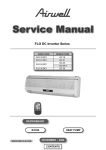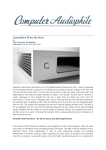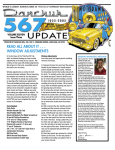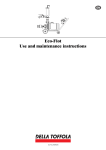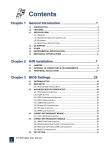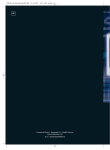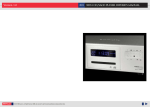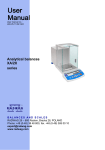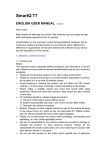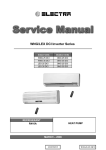Download EMMLabs DAC2X System information
Transcript
A Aurende er W20 Review w by The Comp b puter Audiop phile P Published on 04-01-2014 0 04:10 0 PM Auren nder music se ervers have been part of my m digital playback arsenal since 2011.. I was so o impressed by the Auren nder S10 tha at I placed it on my CASH H List and named it the t 2011 Produ uct of the Ye ear. The S10 0 was the first music m server I'd seen that was built like a high end audio a component with solid engineering on the in nside and o detail on the e outside. stellar attention to The S10 was IT T. However, a couple agues of mine e thought the e S10 was collea a goo od start, but there was much m room for improvement i . It turns out my collea agues were correct. c Not long l after the S10 hit de ealer showro ooms the nder team co ompleted a sta ate of the Auren art listening ro a oom and wen nt to work on something better than the e S10. The prroduct that emerged from this work w the flagsh was hip Aurender W20. The W20 is not an upgraded u S10 0. The only crritical compon nent shared by b the two m models are th he oven-conttrolled crystall oscillators (OCXO). ( Base ed on severa al months of listening, tessting, and c comparing the e W20 to all other serverrs I've used, I conclude th he Aurender W20 is uneq quivocally the e pièce de r résistance of high h end mussic servers. Aurender W20 Hardwarre - No Hocu A us-pocus Jus st Solid Engineering T Aurender W20 hardwa The are and softwa are were designed by mussic loving engineers. High end e audio hoccus-pocus iss antithetical to the princip ples guiding of o this team. The T state of the t art listening room at Aurender's A Seo oul, Korea h headquarters is used to verify v engine eering change es and conce epts impleme ented in Aure ender produccts. When s squeezing outt every ounce e of electrica al and mechanical noise frrom a producct, a very quiiet listening room r with h highly resolvin ng componen nts is a requirement. The Aurender lisstening room contains ana alog compone ents from C Constellation A Audio, digital conversion and a clocking from f dCS, and d loudspeakerrs from Magicco. Several items separate the S e Aurender W2 20 from not only o the Aurender S10 butt most music servers on th he market. A the heart of At o the W20 design d are th he main moth herboard and physically se eparated and d isolated aud dio board. B Both items we ere designed in-house by Aurender engineers. Whe en designing a flagship pro oduct it's neccessary to d design one's own o audio bo oards. Howevver, designing g one's own computer c mottherboard is expensive e and d requires a level of exp pertise not fo ound at manyy high end au udio companies. A major advantage of o designing one's o own m motherboard is the ability to eliminate or drasticallyy reduce elecctrical noise. Most M commerrcial motherb boards are d designed to a very low sta andard comp pared to a hig gh end audio o component.. Commercial board design is often c controlled by accountantss seeking to lower the prrice rather th han improve quality and features acccording to W Wavelength A Audio Founde er and "Godffather" of hig gh end USB audio Gordo on Rankin. Gordon G design ned many m motherboards s for very larg ge computer manufactures before purssuing high en nd audio. One e type of noisse caused b computer components when mixed by d with audio componentss can be hea ard easily. Fo or example, I recently r received a ~$ $10,000 audio o product forr review with built-in WiFii. When the WiFi W is enable ed but uncon nfigured a v very audible ticking noise can be heard through the right chan nnel. Once the WiFi is co onfigured thiss noise is r reduced grea atly but can still s be heard with an ear close c to the right tweeter. Disabling WiFi W on this co omponent e eliminates the e noise. No such s noise ca an be heard through the Aurender. Th he moral of the t story is, computer 1 | P a g e components are electrically noisy. The ability of the Aurender team to craft its own motherboard featuring only the capabilities required for audio reproduction and to layout the board for the best electrical performance separates the men from the boys. Powering this motherboard is a high quality switch mode power supply. This supply only powers the motherboard, hard drives, and front panel OLED display. The W20 audio board is isolated from all other parts of the server by an infrastructure of thick aluminum walls and plates. This board contains a single oven controlled crystal oscillator and high quality parts throughout. Of note is the special USB audio port, dual wire AES/EBU ports, and word clock BNC input. The USB audio port was design to deliver the cleanest possible signal to a USB DAC. (The Aurender W20 has no onboard digital to analog conversion.) Thus, the USB port's location on the audio board rather than the main motherboard. The USB audio signal is buffered, using a proprietary buffering circuit to reduce noise and jitter, prior to transmission to a USB Audio Class 1.0 or 2.0 DAC. The USB audio port's 5V / 1.0A power output can be toggled off and on within the Aurender iPad application. This feature is very nice when connecting to a USB DAC that doesn't require power from a computer such as the Ayre Acoustics QB-9 DSD. There's no sense in sending an unneeded power signal even if it's clean as a whistle. The Aurender W20 runs a custom version of Linux that supports many external USB DACs. There is no user interface to install special device drivers for USB DACs that aren't supported by Aurender's Linux such as those from M2Tech (some not all models) and Mytek. I've tested several USB DACs with the W20 such as the EMM Labs DAC2X, Benchmark DAC2 D, and the Berkeley Audio Design Alpha USB. XMOS based DACs work great for the most part. As a general rule, USB devices that work with Mac OS X without the need to install software / device drivers will work with the Aurender W20. Users with DACs that support other audio interfaces such as AES/EBU, coaxial S/PDIF (RCA & BNC), and optical S/PDIF (TosLink) needn't worry about compatibility with the W20. These interfaces are standards that just work between all devices. More on the AES/EBU interfaces in a bit. Powering this isolated, both electrically and physically, audio board are two banks of lithium iron phosphate (LiFePO4) DC batteries. These banks alternate charging cycles to eliminate negative performance effects of low 2 | P a g e batteries. No user intervention is required, the audio board is always powered by these batteries. The audio board is also isolated from annoying ground noise emanating from the mains outlet powering the rest of the server. An additional bank of LiFePO4 batteries is used as a UPS (uninterruptible power supply) when power is removed from the server altogether. This temporary battery supplies the mother board, hard drives, and OLED display enabling the server to shutdown gracefully and inform the user what's happening via front panel display. The W20's batteries are spec'd to last 3,000 charge-recharge cycles until they reach 80% of capacity. If the W20 is used eight hours per day, 365 days per year, the batteries should last about 40 years. The Aurender W20 features two AES/EBU outputs so it can operate in single or dual mode AES. In the simplest of terms single AES uses one cable and dual AES uses two cables. Both single and dual use digital cables with XLR terminations on each end. This is one major differentiating factor between the W20 and nearly all other music servers on the market. The reason for dual AES on the W20 is that some very high end digital to analog converters from companies such as dCS, Esoteric, and Chord support or require dual AES for sample rates over 96 kHz. The ultra rare and long out of production Pacific Microsonics Model II requires dual AES as well. The Dual AES feature of the W20 is enabled or disabled within the Aurender iPad app. Set it once and forget it. Along a similar line as dual AES, the W20 supports word clock input. Many of the same DACs from dCS, Esoteric, and Chord support word clock output. Systems from dCS and Esoteric are often configured with a separate master clock component that feeds word clock to a physical disc transport, a DAC, and even an upsampler. This same master clock can feed the Aurender W20 thus all the digital components are fed by a single master clock. Clocking is a big deal in digital audio. The fact that the W20 supports word clock input is another major differentiator between it and the competition. During the review period I received a dCS Vivaldi system without the physical disc transport. This consisted of the Vivaldi DAC ($34,999), Vivaldi Upsampler ($19,999), and Vivaldi Master Clock ($13,499). Combined with the dCS stack the W20 fits like a glove. dCS and the Aurender team worked together to enable the W20 to communicate 3 | P a g e with dCS components via RS232. My W20 shipped with a solid aluminum USB to RS232 converter for this communication. Once the dCS Master Clock is connected to the Upsampler, DAC, and Aurender W20 via BNC word clock cables, and the W20 connected to the Master Clock via USB-RS232 the entire system works beautifully without user intervention. Users of dCS will understand what I mean when I say this is a complex system capable of delivering fantastic results. There are other methods of clocking without this W20 - dCS RS232 communication, but the results aren't nearly as good as this preferred setup. For example the DAC could lock on to the incoming audio signal, reading the sample rate as the audio comes into the DAC. Or, a user could manually set the clock on a DAC before switching sample rates. Both of these are less than desirable. The dCS - Aurender communication is terrific. Another more traditional way of getting excellent sound quality is to send word clock out from a DAC into the W20. This places the clock as close to the DAC as possible (actually in it) as preferred by some manufacturers and listeners. Fortunately none of this "clocking business" is necessary if one doesn't have a component capable of sending word clock to the W20. This should cover 99% of users as most DACs do not feature word clock in or outputs. The W20 is capable of stellar sound quality with or without an external clock feed. When using the W20 with my Alpha DAC Series 2 I simply connected a single AES cable between the Alpha and Aurender. This same configuration was used with the EMM Labs DAC2X in my system. Complexity isn't compulsory for quality. An external clock feeding the W20 should be considered the icing on the cake when used in the correct system. In addition to working with dCS on DAC / Master Clock communication the Aurender team has worked with both Constellation Audio and Berkeley Audio Design. My W20 also shipped with an RS232 to USB adapter that works with Constellation Audio preamplifiers. Once connected the Aurender iPad application enables control of the Constellation Audio preamp's volume, input selection, and phase. The Aurender iPad app then becomes the only remote needed for daily use of a W20 / Constellation based system. At a CES 2014 dinner my friend, industry veteran, and Aurender dealer Tim Marutani suggested to the Aurender team that they enable USB to infrared control for the forthcoming Berkeley Audio Design Alpha DAC Reference Series. Close to 24 hours later an Alpha DAC was scheduled for delivery to Seoul for testing and the Aurender team had a design for a nice USB to IR 4 | P a g e adapter in mind. Work on the final implementation of this USB to IR communication is in progress as of the writing of this review. I hope to test this feature when I receive an Alpha DAC RS in the next couple weeks. The Aurender W20 ships in two configurations. The 6TB (2x3TB) model for $16,800 and an 8TB (2x4TB) model for $17,200. The W20 features an SSD for caching music in the queue enabling the larger spinning drives to wind down. These spinning drives are suspended on rubber and located inside a block of machined aluminum that minimizes vibrations and noise, both electrical and acoustic. The drives are independent, as opposed to combined into a single large drive. The user connecting to a W20 over the network sees both HDD1 and HDD2, each 3TB or 4TB depending on the model. This is one item I wish was user configurable. I prefer to have both drives combined into a single large drive of 6TB or 8TB. This would make copying files easier and space management nonexistent. Currently my W20 has two 3TB drives. I have an A-K folder on HDD1 and both L-Z and DSD folders on HDD2. If my collection music in the A-K folder grows larger than a single disk can hold, I'll need to reconfigure the folder structure. Fortunately, if I create an A-K folder on both HDD1 and HDD2 the Aurender will see these as a single folder when using the folder filter button. This isn't ideal, but it's also not the end of the world or a show stopper. The possible pitfalls of combining both drives into a single larger drive may have to do with adding either hardware or software RAID to the W20 or the fact that losing a single disk would wipe out one's entire music collection rather than half of the collection. Users should worry about losing their music in the event of a drive failure because everyone has a backup, right? If the W20 can be setup for a single large drive I'd love the ability to toggle this on or off from within the iPad application. Aurender W20 Software - No Hocus-pocus Just Solid Software The software running on the Aurender W20 is nearly identical to all other models. The only differences are related to support for hardware such as word clock input and dual AES output. The Aurender servers feature Remote Support capability. There are a couple methods of enabling this remote support, one from the actual W20 and the other through the iPad application. Remote support must be enabled by the end user and is only necessary if the user encounters a problem. Once enabled via the iPad app the Aurender team receives an email containing very general system information such as software versions of the system software and the iPad 5 | P a g e application, and any description of the problem provided by the end user. Upon receiving notification of a problem, initiated by the user, the Aurender team can access the W20 remotely to diagnose and correct issues. This remote access requires no configuration or user intervention other than enabling the feature. I know people who have used this feature in the field and have been very happy with Aurender support. I've used it myself and had great results. The feature seems time limited in that I've enabled it and had to re-enable it because the Aurender team didn't connect immediately. I did't expect immediate assistance as the team doesn't have a 24/7 support staff monitoring and connecting to systems around the world. Not even multi-million dollar computers in enterprise datacenters come with that level of service without hefty service agreements costing tens of thousands of dollars per year. Nonetheless, this remote support feature built into all Aurender servers is very valuable. It's one feature that really separates the Aurender servers from a Mac OS X or Windows based music server maintained by the end user. Another software feature that increases the Aurender value proposition for many users is the ability of the servers to run for months without user intervention required. There are no security vulnerability patches that must be installed immediately and there is no fear of impending doom such as that associated with Microsoft's end of support for Windows XP on April 8, 2014. After this date Microsoft will no longer release updates for Windows XP. There is speculation that malware creators are holding back a barrage of viruses and exploits until Microsoft's support ends. After April 8 it may be game on for hackers and end users may be SOL. On the other hand April 8th may come and go just like Y2K without any major issues for those who have prepared and even those who called the Y2K bluff like Italy and Paraguay back in the day. For some music lovers the thought of updating a music server or even reading about potential issues, however real or benign, is enough to sway them toward a canned server like the W20. The Aurender W20 works like a toaster. When bread is placed in a toaster, the user will have toasted bread in a matter of minutes. Period. When music is placed on the W20, the user will have music at the ready day or night for months on end. Period. Aurender users without issues or the need for more features can simply keep on keepin' on. Why fix what's not broken? Users in need of features like DSD support can easily upgrade the Aurender software by tapping the upgrade button within the iPad application. When DSD support was ready, it was made available for free to all 6 | P a g e Aurender users. This update included support for DoP version 1.2, DSF and DFF files, sample rates through DSD128 (5.6MHz) via USB output, and rates through DSD64 (2.8MHz) on other outputs. Some DSD fans have ISO images of SACD discs in their collections. The W20 won't play ISO images due to issues with metadata and caching, however the Aurender software has a built-in ISO to DSF converter. Once the ISO image is converted to individual DSD files the ISO image is deleted from the hard drive. Users seeking DSD to PCM conversion for playback through DACs such as the Berkeley Audio Design Alpha series currently need to convert their DSD files to PCM one time before copying them to the W20. The W20 and all Aurender servers support PCM bit depths up through 24 bits and sample rates up through 192 kHz. The Aurender iPad application is currently the only method of remotely controlling playback. The Aurender team is currently working on an Android version of its application. Testing is being done on the Samsung Galaxy Note Pro 12.2 and a few other tablets. The team has been hesitant to release an Android version due to the fragmentation in the Android market. The number of Android devices with varying levels of performance, screen sizes, and versions of the operating system can be a nightmare for app developers seeking to create the smoothest of end user experiences. At CES this year Harry Lee, creator of Aurender and now Director of parent company TVLogic's SmartAudio Division, was working out details for a power search feature available only on 64 bit iPads. Users with more powerful 64 bit iPads will eventually see this feature while those with lesser capable units will continue using the very good standard search feature. A number of important items I look for in an iPad application are speed, stability, capability without too much complexity, and a visual aesthetic that serves the end user by increasing functionality. Speed is critical. Like many users my patience wears thin if an application pauses for a couple seconds between finger taps or has a slow search speed. The Aurender iPad application is very fast. It's search speed is more like an online filter that dwindles down the results as the user types a search term. I've never had to type in an album 7 | P a g e name or band name and had to tap the actual Search button in order to view results. The results are immediately available as one types. I currently have 4,503 albums consisting of 56,441 tracks stored on the W20. Whether I'm searching albums or the entire database of tracks the search results are immediate as I type. The same cannot be said for most iPad applications in use by high end audio manufacturers. Stability is critical. Without stability nothing else matters. An app that crashes or doesn't function deterministically will only increase user frustration and possible embarrassment. In high end audio circles there is nothing worse than giving a demonstration to friends or family with equipment that doesn't work. Most of us have been in that situation. "Hey check out my new system. Oh wait, something isn't right. It should be working. I just had it playing music before you arrived, honestly." Official release versions (non-beta) of the Aurender iPad application are rock solid. If a feature decreases stability of the app during beta testing the Aurender team will perfect the feature before release or the team won't release it to the public. Since I started using the Aurender iPad app in 2011, stability has been very good. Capability without complexity is critical. An app must have most of the features users want but mustn't be overly complex. What good is a professional digital audio workstation as a home music server? All the capabilities for playback are there, but the level of complexity very high and the learning curve is way too steep. The Weiss Engineering MAN301 network player has a long list of capabilities, but the user manual is 197 pages of required reading. I was unable to use the MAN301 without reading the manual. The Aurender iPad application is very capable and easy to use without instruction. Mastering all the ins and outs of the app requires a few quick tips from someone in-the-know such as a dealer, but general use of 99% of the capabilities is easy and intuitive. The Aurender iPad app features several different styles of browsing one's library such as by Artist, Album, Genre, Song, Composer, Conductor, and even by folder. Users can also create folders on the Aurender's drives that appear across the top of the iPad app. For example I have all my DSD content in a DSD folder on HDD2. The iPad app displays a button titled DSD, that when tapped displays only the content in that folder. The display isn't folder-like at all rather it shows the album covers, album title and artist name. Since the beginning days of the 8 | P a g e Aurender iPad app it has featured press and hold capability. When a user presses a finger on an item such as an album, a popup menu appears with options. The Aurender press and hold options include Play Now, Play Random, Replace Queue, Add To Next, Add To End, Show Album Cover, Artist, Album, and Add to a playlist among others. Press and hold capability decreases complexity greatly. It surprise me every time I use an app without this capability. Selecting an album or track, then finding how to accomplish the task at hand via a button somewhere (add to next, etc...) or to find out the capability is missing because of lack of GUI space, is preposterous in 2014. It was almost preposterous in 2011. Press and hold with the "correct" amount of options is mandatory for apps to be in the top tier of capability without complexity. The Aurender app is great but it isn't perfect. One complaint I have with the app is its inability to edit metadata. After ripping or downloading files to the Aurender I often notice little errors such as artist name misspellings, incorrect capitalization, or a missing album title identifier (DSD64, 24/96, etc...). I add this identifying information to the titles of my albums to make differentiate between several versions of the same album much simpler. I would love the metadata editing capability built into the Aurender iPad app. I could simply edit all this information right from an iPad. Currently I open JRiver Media Center on my Mac or PC to edit this information on the W20. Editing metadata isn't rocket science. I wish the Aurender had this capability. Visual aesthetic that serves the end user by increasing functionality is critical. Technology must serve the user of said technology. Too often geeks, techies, or companies, without knowledge their end users, create applications that are beautiful but this beauty serves no function needed by the end user. For example, Apple used to feature Cover Flow in its iTunes application. In a world with hundreds of millions of iTunes users I'm sure one or two people actually used this feature for more than a week, but it was worthless. Apple used this technology for technology's sake. Cover Flow was a solution in search of a problem. It was aesthetically pleasing for sure, but was also a functional nightmare for browsing more than 100 albums. Aesthetics that serve functionality can be as simple as a user interface color that is easy to read and doesn't shock one's pupils when viewed in the dark. The 9 | P a g e Aurender iPad app is visually very nice and serves the end user well. For example, the letters of the alphabet along the right edge of the screen are very subtle and are only highlighted when in use. This helps keep the user's mind on music rather than a cluttered interface resembling an Excel spreadsheet. The Aurender iPad application features a slide-able window to view album covers yet still view the queue. When visible this window enables easy selection of music in one's entire collection or the limited number of tracks in the queue. This same slide-able window covers up lesser used controls, buttons, and metadata yet these features remain easily accessible with the flick of a finger. This visually pleasing sliding window serves functionality. One item within the app that appears to serve no purpose but to delay the users' navigation is the "spinning" of album art and "page peel" when viewed in full screen mode. For example, when tapping the currently playing album's cover image in the upper left corner of the app, a full screen image of the cover art appears. On this screen the user can switch to view the queue in full screen but after tapping the button the entire window either spins around 180 degrees or does the PowerPoint-like page peel effect on its way to displaying that which the user selected. This is using technology just because one can. My biggest problem with the Aurender iPad application is its lack of high resolution thumbnails for all the album art. I mainly browse my entire collection by scrolling through the album view within the app. The small cover art images in this view are less than good. Much of the text on album covers is illegible, not because it is too small but because of the amount and type of image quality and file size reduction used by the Aurender app. A visually appealing cover image in high resolution enables easier recognition of specific items such as an Analogue Productions logo or Mobile Fidelity stripe identifying an Original Master Recording on top of the album cover. Plus, looking at pixelated images in 2014 on an iPad more powerful than many computers ten years ago can really enhance one's experience with an audio system as a whole. An example of high resolution thumbnails done right can be seen in the JRemote iPad application for controlling JRiver Media Center. Fortunately the Aurender iPad application displays a very high resolution image, provided the user included such a quality version, when viewing the album art in full screen. The application also displays 10 | P a g e rear albums covers when included with the file. Overall 99% of the Aurender iPad app is aesthetically pleasing and serves to increase functionality for the end user. Aurender W20 In Use - No Hocus-pocus Just Listening The Aurender W20 is built for music playback only. It has no CD ripping capability and no user interface for music management. In my experience this is just fine. I already have a computer, or two or three, with which I have CD ripping software (XLD on Mac OS X and dBpoweramp on Windows) and music management software (JRiver Media Center). It's likely that all users reading Computer Audiophile or considering an Aurender W20 already have a computer for ripping and music management as well. Once a user's music is moved to the W20 there is no need for another computer. There are several different work flow options for populating an Aurender full of music and updating the unit after each new music purchase. It's possible to connected a USB hard drive directly to the W20 and have the unit automatically copy the files to the internal hard drives. Techies often call this method sneaker net as it involves walking the files from one location to another. There's nothing wrong with this method, it's just not the most efficient. It's also possible to rip CDs directly to the W20 and to download new music from sites like HDtracks directly to the W20 over the server's Ethernet connection. This method is the most efficient. Editing metadata can be done by pointing an application such as JRiver Media Center to the W20's hard drives. All the music on the W20 then appears within JRiver Media Center and all metadata changes are save directly to the W20. The method I use for populating the W20 is to work with all my music locally on my laptop before copying it to the unit. My situation is a little different from most users as I have copies of music on several different servers and NAS units. Needless to say the Aurender W20 is very flexible and enables the listener to use whatever method is most desirable. Aurender music servers don't have any built-in disk redundancy. This means when a hard drive fails and is subsequently replaced, the music must be copied back to the unit. I haven't had a single hard drive issue using four different Aurender servers since 2011. While using Aurender servers over the years I established a very simple method of backing up the servers and keeping the backup copies current. This method requires no user 11 | P a g e intervention after initial setup and delivers a success/failure backup report to the user's email inbox after each backup. This method is very easy to setup using a Synology NAS and requires no backup software on the Aurender. From my Synology DS1812+ I set the File Manager to connect to the W20 HDD1 and HDD2 drives and check the box to automatically reconnect upon reboot of the NAS. Once connected the W20 drives appear just like local folders on the NAS. I then setup a backup task that copies all music on both W20 hard drives to a folder on the Synology NAS. This task runs every Sunday morning at 4:00AM. After the backup succeeds or fails I receive an email in my inbox with the status. After the initial full backup all subsequent backup tasks only copy the data that has changed or been added. All the hard work is done by the Synology. This enables the Aurender W20 to remain a dedicated high end music playback device rather than a full blown computer running all kinds of software. I've had the Aurender in my system for several months and have used a number of audio components with the W20. I've tried the USB, AES, and coaxial S/PDIF interfaces of the W20 with numerous DACs including a full dCS Vivaldi stack, Berkeley Audio Design Alpha DAC Series 2, EMM Labs DAC2X, Ayre Acoustics QB-9 DSD, and Auralic Vega to name a few. The W20 works great with all of these DACs. Connected to the Ayre QB-9 DSD I disabled the W20's USB power output because the DAC's USB interface doesn't require power from the server. Connected to the Berkeley Audio Design Alpha DAC Series 2 I used the AES output. I also tried the Alpha USB, with W20 USB power enabled, to convert USB to AES between the Alpha DAC and W20. There is no single "best" way to connect a DAC to the W20. There are just too many variables to declare a wining interface. The W20 is very versatile and offers an incredibly clean audio signal to any connected device on any interface. Currently I have the W20 connect via AES to the Alpha DAC Series 2. The Alpha is connected directly to Pass Labs XA160.5 monoblocks via Mogami professional balanced XLR cables. The Pass amps are driving TAD CR1 loudspeakers via MIT speaker cables. The W20's battery powered audio board is a huge sonic step up from the previous Aurender S10. Output via AES into the Alpha DAC Series 2 is dead quiet without a hint of digital noise that can be associated with computer audio sources. Listening to either my usual review playlist or one of the hundreds hundreds of albums I played through the W20 over the last several months, the sound quality was as 12 | P a g e good as it gets. The W20 does exactly what high end listeners want, it delivers the best possible audio signal available. Without a source of this caliber there is no way to drive one's system to the fullest. The source material can't get better than the weakest link in the chain. It just makes sense to start with the best signal one can afford. Listening to Doug MacLeod's There's A Time at 24/176.4 from the Aurender W20 enables one to hear this recording to the fullest. The recording space, air around Doug's voice and guitar, and sense of realism that can be heard in this wonderfully engineered album are astounding. I recently downloaded Sara Bareilles' album Brave Enough - Live at the Variety Playhouse at 24 bit / 96 kHz. I copied it to the W20, queued it up, and let it play on repeat. The entire album sounds terrific sourced form the W20. The low level detail audible when listening to the album in the background is stellar. The sound quality is incapable of inducing fatigue. I also listened to this album at concert levels and enjoyed every minute. Sara's cover of Goodbye Yellow Brick Road not only sounds superb but the way she make it her own is just enough twist to get lost in the song without thinking about Elton John (video). Music lovers and high end audio aficionados long to hear exactly what's on a recording without their equipment editorializing. The Aurender W20 delivers listeners the best shot at this true reproduction. Comparing the W20 to a CAPS v3 Carbon server revealed the sonic limitations of an off the shelf computer music server. Even though the CAPS v3 Carbon server is completely powered from LiFePO4 batteries it doesn't deliver the music signal to the rest of the audio chain as well as the Aurender W20. The CAPS server sounded like it was adding digital artifacts and giving a false sense of clarity and detail compared to the W20. This type of sound can lead listeners to conclude the CAPS server offers more detail or enables one to hear more of his music than the W20. However, I caution against jumping to such a conclusion. Hearing things that one has never heard before can be a fantastic experience, as long as those things are in the recording. Compared to other servers I've used over the last several years, not including the W20, the CAPS v3 sounded fantastic and much better for the most part. Now that I've lived with the W20 for an extended period of time I've finally found a server that I cannot top with my own build or with any other server I've yet heard. There is a tendency to favor that which one builds himself because there is an intimate level of knowledge about such a server, or any other component for that 13 | P a g e matter. We often look at other servers without knowing what has been done to them and assume there must be a few items that could be removed or changed for better sound quality. This way of thinking just doesn't hold water. In addition to sonic superiority the W20 is superior in every way related to ease of use. The server will run "forever" without user intervention. There is no way to even connect a keyboard, monitor, or mouse to the W20. It's not that kind of component. There's no need for a remote control application like Splashtop, Microsoft Remote Desktop, VNC, etc... The W20 is controlled by the Aurender iPad application, that's it. Conclusion The Aurender W20 is a purpose built race car that does one thing very well, it plays music that sounds better than any server I've ever used. When connected to great components the W20 enables one to hear into the music, with a low noise floor and clean signal, like nothing else. The flagship W20 is an engineering based marvel not dependent on high end hocus-pocus to turn heads and enthrall the ears. The server's maintenance free battery powered, and in-house designed, audio board in addition to intense isolation, both electrical and physical, are far beyond any server I've used to date. The Aurender W20 makes CAPS servers look like children's toys with inferior sound. It's not possible to compete with the W20 using an off the shelf computer or individual computer components cherry picked from around the world. The Aurender team has designed and built, from the ground up, the W20 too such a standard, hobbyists can only dream about duplicating its form and function. Whether the listener connects it to a full dCS externally clocked stack or an Alpha DAC via AES or an EMM Labs DAC2X via USB the Aurender W20 will provide listeners the best chance of hearing everything on a recording without editorializing. The Aurender W20 has displaced the CAPS v3 Carbon server in my system and is without a doubt the best music server I've used to date. 14 | P a g e • Produ uct Informa ation: • o Product - Aurender A W20 0 o Price - $16 6,800 (6TB), $17,200 $ (8TB B) o Product Pa age - Link Wherre To Buy The Audio A Salon Assoc ciated Equip pment: o o o o o o o o o o o • Source: C.A.P.S. v3 Carrbon Server DAC: Auralic Vega, Berkkeley Audio Design D Alpha DAC D Series 2,, Berkeley Aud dio Design Alpha USB, EMM Labs DAC2X, Ayre e Acoustics QB B-9 DSD Amplifier: Pass Labs XA A160.5 Monob blocks Pre-Ampliffier: Pass Labss INT-30A Pre/Ampliffier: Devialet 170 Loudspeak kers: TAD Lab bs CR1 Compa act Reference e Remote Co ontrol Software: JRemote, Remote Co ontrol Hardwa are: iPhone 5,, iPad (3rd Ge eneration) Network Attached A Stora age (NAS): Syynology DS18 812+ Cables: Au udioQuest Nia agara Balance ed XLR Analog g Interconneccts, ALO Audio o AC6 Power Cables Network: Cisco C SG200-2 26 Switch, Ba aaske MI-1005 5 Ethernet Iso olator, AudioQ Quest Diamon nd, Vodka, Cin nnamon Etherrnet Cables, Apple A AirPort Extreme, PFS Sense Router / Firewall, Cissco DPC3000 Docsis D 3.0 cab ble modem, Comcast C Extre eme 105 Mbp ps Internet Se ervice Assoc ciated Music c: o Frequently y Used Review w Playlist 15 | P a g e Artist Cecile McLorin Salvant Randi Tytingvag Roger Waters Sam Cooke Shelby Lynne Shelby Lynne Shirley Horn Solomon Burke Stan Getz / Joao Gilberto Supertramp Tim Ries Yo-Yo Ma ZZ Top Ottmar Liebert Pink Floyd Nat King Cole Nat King Cole Melody Gardot Mark Knopfler Marc Cohn Livingston Taylor Leonard Cohen Keith Richards Keb' Mo' Justin Timberlake Joni Mitchell Joni Mitchell John Hiatt Joe Pass Jimmy Cobb Jimi Hendrix Jewel James Taylor Jack Johnson Jack Johnson Glen Hansard Gary Karr Garth Brooks Elvis Costello Dusty Springfield Doors, The Diana Krall Diana Krall David Oistrakh Cowboy Junkies Chet Baker Buddy Holly Boz Scaggs Bob Dylan Bjork Big Phat Band Band, The A.A. Bondy Lou Reed Album Track # WomanChild (24 bit / 96 kHz) (HDtracks) 1 Red (24 bit / 44.1 kHz) (Linn) 1 Amused to Death 3 Night Beat (1 bit / 2.8224 MHz) 1 Just A Little Lovin' (Analogue Productions) (1 bit / 2.8224 MHz) 1 Tears, Lies and Alibis 3 You Won't Forget Me 4 Don't Give Up On Me 1 Getz/Gilberto (Japanese) (1 bit / 2.8224 MHz) 6 Crime of the Century (24 bit / 192 kHz) 1 The Rolling Stones Project 5 Solo (1 bit / 2.8224 MHz) 1 Tres Hombres (24 bit / 192 kHz) (HDtracks) 8 One Guitar (24 bit / 96 kHz) (HDtracks) 3 Wish You Were Here (Analogue Productions) (1 bit / 2.8224 MHz) 4 The Very Thought Of You (Analogue Productions) (1 bit / 2.8224 MHz) 1 Love Is The Thing (Analogue Productions) (1 bit / 2.8224 MHz) 1 My One and Only Thrill 1 One Take Radio Sessions 1 Listening Booth: 1970 11 Ink (24 bit / 96 kHz) (HDtracks) 1 Old Ideas 3 Main Offender 4 Keb' Mo' (1 bit / 2.8224 MHz) 1 The 20/20 Experience (Deluxe Edition) 1 Hits 7 Hits 4 Bring The Family (1 bit / 2.8224 MHz) 10 Virtuoso (XRCD) 1 4 Generations Of Miles (1 bit / 2.8224 MHz) 1 The Ultimate Experience 3 Sweet and Wild (Deluxe Edition) (Disc 2) 9 Sweet Baby James (Audio Fidelity 24KT Gold) 1 Brushfire Fairytales (2011 Remaster 16 bit / 48 kHz) 1 In Between Dreams 1 Rhythm And Repose (24 bit / 96 kHz) (HDtracks) 2 Bass Virtuoso (HDAD 24 bit / 192 kHz) 1 Fresh Horses 10 North (24 bit / 88.2 kHz) (HDtracks) 4 Dusty In Memphis (24 bit / 192 kHz) 3 The Doors (Analogue Productions) (1 bit / 2.8224 MHz) 11 The Girl In The Other Room (1 bit / 2.8224 MHz) 4 Live In Paris 11 Bruch: Scottish Fantasia; Hindemith: Violin Concerto 1 Whites Off Earth Now (MFSL) (1 bit / 2.8224 MHz) 1 Chet (Analogue Productions) (1 bit / 2.8224 MHz) 1 Icon 12 But Beautiful (Import) 1 2 The Freewheelin' Bob Dylan (MFSL) (1 bit / 2.8224 MHz) Biophilia (24 bit / 96 kHz) (HDtracks) 9 Big Phat Band 1 The Last Waltz (2003 Remaster) (Disc 2) 15 American Hearts 7 Walk On The Wild Side 12" 1 Track Name St. Louis Gal Red Or Dead Perfect Sense, Part I Nobody Knows the Trouble I've Seen Just A Little Lovin' Like a Fool Beautiful Love Don't Give Up On Me So Danco Samba School Wild Horses (Featuring Norah Jones) Mark O'Connor: Appalachia Waltz (solo cello version) La Grange Along this Road: Kono Michi (YV) Wish You Were Here The Very Thought Of You (STEREO) When I Fall In Love (Stereo) Baby I'm a Fool The Trawlerman's Song Into the Mystic Isn't She Lovely Show Me the Place Words of Wonder Every Morning Pusher Love Girl California Woodstock Learning How To Love You Night and Day There Is No Greater Love Hey Joe One True Thing Sweet Baby James Inaudible Melodies Better Together Maybe Not Tonight Track 01 She's Every Woman You Turned To Me Son Of A Preacher Man The End Almost Blue A Case Of You Introduction. Grave. Adagio cantabile Shining Moon Alone Together True Love Ways My Funny Valentine Girl from the North Country Crystalline Sing Sing Sing The Last Waltz Suite: The Weight World Without End Walk On The Wild Side Duration 3:01 AM 4:31 AM 4:16 AM 3:27 AM 5:16 AM 3:58 AM 3:39 AM 3:45 AM 3:32 AM 5:34 AM 8:01 AM 4:26 AM 3:52 AM 3:40 AM 5:33 AM 3:51 AM 3:12 AM 3:31 AM 5:13 AM 3:13 AM 4:37 AM 4:09 AM 6:35 AM 3:02 AM 8:02 AM 3:50 AM 5:27 AM 4:10 AM 3:35 AM 8:59 AM 3:25 AM 4:09 AM 2:52 AM 3:38 AM 3:27 AM 5:30 AM 8:39 AM 2:51 AM 2:31 AM 2:26 AM 11:47 AM 4:04 AM 7:04 AM 8:41 AM 4:06 AM 6:50 AM 2:50 AM 4:55 AM 3:23 AM 5:08 AM 4:22 AM 4:36 AM 2:31 AM 4:13 AM File Type flac flac flac dsf sacd flac flac flac sacd flac flac dsf flac flac dsf dsf dsf flac flac flac flac flac flac dsf flac flac flac sacd flac dsf flac flac flac flac flac flac flac flac flac flac sacd dsf flac flac sacd sacd flac flac sacd flac flac flac flac dsf Sample Rate 96000 Hz 44100 Hz 44100 Hz 2822400 Hz 2822400 Hz 44100 Hz 44100 Hz 44100 Hz 2822400 Hz 192000 Hz 44100 Hz 2822400 Hz 192000 Hz 96000 Hz 2822400 Hz 2822400 Hz 2822400 Hz 44100 Hz 44100 Hz 44100 Hz 96000 Hz 44100 Hz 44100 Hz 2822400 Hz 44100 Hz 44100 Hz 44100 Hz 2822400 Hz 44100 Hz 2822400 Hz 44100 Hz 44100 Hz 44100 Hz 48000 Hz 44100 Hz 96000 Hz 192000 Hz 44100 Hz 88200 Hz 192000 Hz 2822400 Hz 2822400 Hz 44100 Hz 44100 Hz 2822400 Hz 2822400 Hz 44100 Hz 44100 Hz 2822400 Hz 96000 Hz 44100 Hz 44100 Hz 44100 Hz 5644800 Hz Bit Depth 24 24 16 1 1 16 16 16 1 24 16 1 24 24 1 1 1 16 16 16 24 16 16 1 16 16 16 1 16 1 16 16 16 16 16 24 24 16 24 24 1 1 16 16 1 1 16 16 1 24 16 16 16 1 Bitrate 4609 2114 1412 5644 5644 1412 1412 1412 5644 9219 1412 5644 9231 4609 5644 5644 5644 1412 1412 1412 4609 1412 1412 5644 1412 1412 1412 5644 1412 5644 1412 1412 1412 1536 1412 4609 9219 1412 4235 9219 5644 5644 1412 1412 5644 5644 1412 1412 5644 4609 1412 1412 1412 11289 File Size 101 MB 69.7 MB 43.3 MB 140 MB 1.6 GB 40.3 MB 36.9 MB 38.0 MB 1.3 GB 367 MB 81.1 MB 180 MB 258 MB 122 MB 224 MB 156 MB 130 MB 35.8 MB 52.9 MB 32.7 MB 152 MB 42.2 MB 66.6 MB 123 MB 81.3 MB 38.9 MB 55.3 MB 3.0 GB 36.4 MB 363 MB 35.1 MB 42.2 MB 29.1 MB 40.9 MB 35.2 MB 182 MB 572 MB 29.0 MB 76.9 MB 161 MB 2.8 GB 165 MB 71.7 MB 87.8 MB 3.8 GB 2.3 GB 28.7 MB 99.6 MB 2.0 GB 170 MB 90 MB 46.6 MB 25.8 MB 341 MB




























